Episode 800 of my “Car Con Carne” podcast releases on December 12. (YouTube, Apple, Spotify, Audible, Google, etc.). After all this time of hosting, booking, producing and marketing the show, I still find myself learning new things about the medium and its possibilities.
Here are nine lessons I’ve learned since launching on June 6, 2014, along with the stretch of episodes that taught me those lessons.
Chase the idea (Episodes 1-34)
Car Con Carne started as a show co-hosted with my friend, Mike Bratton. We originally planned to do a barbecue podcast, recorded onsite at different BBQ locations around Chicago and its suburbs.
It was a fairly impractical idea, given that background noise and getting permissions to record onsite would vex the product and its administration with each new episode. As we faced that reality, Mike had the genius idea of recording each episode in my car.
As a professional voice over artist, he noted that he frequently had to record voice tracks when he was away from his studio. His solution for those moments? Jump in the car with a microphone and laptop. If a studio’s not available, cars tend to be as close-to-soundproof as you can get.
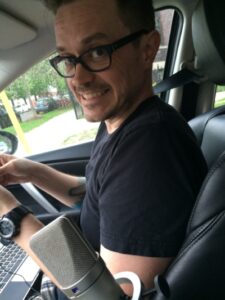
Recording a car-based food podcast was an unorthodox idea at the time, as entertainment produced in cars hadn’t yet become a mainstream concept. “Comedians in Cars Getting Coffee” had been running as a web series for just under two years. “Carpool Karaoke” was still a year from becoming reality. Local TV journalist Anthony Ponce’s car-based podcast, “Backseat Rider,” was also still a couple years away (and he got a money deal right out of the gate, too. Pffft). The Chicago-based video series “No. 6 With Cheese” also started around the same time as “Backseat Rider.”
That said, our podcast concept was, to my knowledge, something new to the medium.
New, and insane.
And challenging to pull off.
But we loved the idea. It was difficult then (to say nothing of the present) to create a podcast concept that felt fresh, with all the show concepts clogging RSS feeds across the world. We were convinced we had found our own angle and lane.
Our pilot episode had us recording the show while the car was moving; a trick that would never again be duplicated. We stayed parked from that point forward, and that approach has been the “red thread” for Car Con Carne.
Again… not easy to pull off. Producing the show required lots more gear than a typical podcast required. Beyond that, creating audio content with physical obstacles (food) created plenty of editing difficulties (I’ve long since given up on editing chewing noises; I now consider them a “gift with purchase”).
We loved our idea. We believed in our idea. We enjoyed eating barbecue. We chased our idea and made it happen. Had we decided the logistics were too messy, or the concept was too unwieldy to work, we might have only stuck around for a few episodes and then quit … or not started at all.
Change is necessary; change is good (Episodes 35-38)
Mike left the show in November 2015, as he was finalizing plans to move to another city with his family.
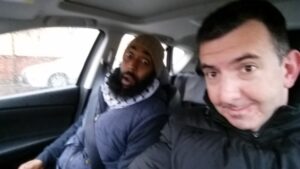
It was a turning point moment for the podcast; one that gave me an opportunity to shake up whatever status quo had been created over the previous year and a half. With Mike moving on, I made four major changes heading into Episode 35 (11/6/15):
- I became the sole host. Instead of finding a replacement for Mike, I decided to turn each episode into an interview opportunity. I took full possession of the content, production and marketing.
- Barbecue was out. It was too limiting to focus on one cuisine, and the list of available restaurants I could visit was rapidly shrinking. I transitioned Car Con Carne into a general food podcast, which allowed me to go to any restaurant, brewpub or eatery in the city, suburbs or exurbs.
- Scheduling. After a biweekly, sometimes monthly, cadence, I took the show weekly. I assumed a more consistent schedule would help build an audience. The metrics immediately backed that up.
- I changed the logo. I thought of the change as a visual indicator that things were different. “Version 2.0” had started.
Those changes put me in a great spot to grow the show creatively, financially, and perceptually. More importantly, the changes energized me and made it so that the podcast was something I loved and looked forward to with each episode. That feeling has never gone away.
Lean on your friends (Episodes 39-105)
When Car Con Carne makes its first million (it can happen!), the first thing I’m going to do is hire a producer to help book guests.
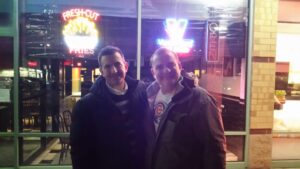
As any podcaster will tell you, booking and scheduling a podcast is a grind. Non-responses from potential guests generally happen at a 10:1 ratio to actual replies. That number’s improved through the years, but it’s still a frustrating task.
To keep the show’s weekly schedule going, I leaned (and continue to lean) on friends and creatives I’ve met, worked with and encountered throughout my career. Instead of chasing impossible-to-land celebrities, I asked local musicians and media personalities I knew… even old high school friends … to jump in the car. They were happy to do it, and I’m grateful to them all for helping me build the show’s foundation.
You’re allowed to ask for help (Episodes 106-250)
Three years into the show, I decided it was the right time to pursue show sponsorship. Podcasters new to the medium may hear Stamps.com or MeUndies ads on their favorite shows and think ad dollars are easy to mine.
In simplest terms: They’re. Not.
I didn’t have the metrics to approach potential advertisers with “CPM” (cost per thousand) rates. I knew I had to sell the show based on concept, execution, and its small-but-highly-engaged audience.
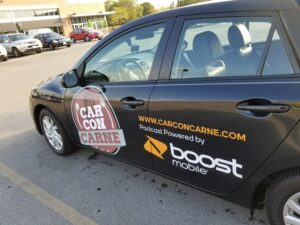
Problem was, I hadn’t a clue about how to start. Rather than sit and stew, or Google my way through a dozen mansplainy, frustrating, blog posts, I decided to ask for help.
I went on my personal Facebook page and asked if anyone in my network would be interested in sponsoring my up-and-coming podcast.
Shortly after posting, a wonderful person in my network messaged me about an opportunity with the cellular company she represented. From there, I created my first-ever advertising deck with show information and rates. Within weeks, I’d negotiated a year-long title sponsorship.
The interesting thing about asking friends, acquaintances and interested passersby for help? More often than not, they want to help.
Go with the flow (Episodes 314-612)
There’s a bit of “change is necessary” in this lesson, but the bigger message here is to give yourself permission to go with the flow.
When COVID kept us all at home, starting in March, 2020, I was left wondering how to keep the podcast going. I couldn’t record with strangers in my car anymore… I couldn’t leave the house… I needed solutions, fast.
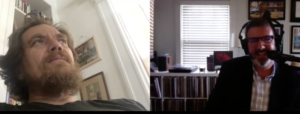
On March 13, I decided to move Car Con Carne to a virtual-only show for the duration of the pandemic. After some quick research, I bought a subscription to Zoom and recorded my first virtual episode on March 14.
Since I was going to be stuck at home, I also made the decision to record a new episode every weeknight. That served the dual purpose of keeping the brand alive while also keeping me connected to people at the most disconnected period in our shared history.
The approach was completely different from what I’d created with Car Con Carne, but I had to go with the flow. I couldn’t change the reality of the world around me, so I had to find a way to adapt to it.
I recorded 296 episodes from home before returning to my car on May 26, 2021.
Apply what you’ve learned (Episodes 613-799)
Emerging from COVID, I appreciated the flexibility virtual recording gave me. It allowed me to talk with people who weren’t able to meet in person. I learned how to make virtual recording part of my toolkit during the pandemic, and made it a part of the Car Con Carne brand.
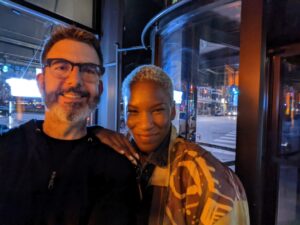
My approach is now a hybrid model: In-car and online. It’s a model that works well with my lifestyle, and has allowed me to record at least two shows per week. The days of daily interviews are in the rearview, but as podcasting goes, I still keep a busier-than-most schedule.
The added benefit of keeping virtual recordings as an option is that we’re still not done with COVID.
I need to revert to virtual recording when public health calls for it. I’ve had to do that twice since returning to the car: When Omicron and Delta both had their moments, I Zoomed my way through them.
Fill your skills gap (Episodes 715-744)
Something that had bugged me through the early years of the podcast was my lack of video production knowledge. I perceived it as a weakness, and I struggled to learn the basics.
I started capturing video of my podcast interviews in 2017. Back then, the videos were Facebook Live recordings, streamed from my Samsung Galaxy S9 phone.
The audio heard on those videos is what was picked up by my phone’s microphone. The much higher-quality audio captured for the podcast episodes, using Sennheiser microphones and a hard drive recorder, was completely separate.
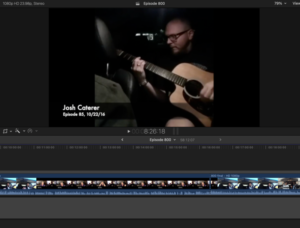 I knew the videos needed to look and sound better, so I invested in an actual streaming camera. The videos looked great, but the same audio issue plagued me: I couldn’t wire my podcast mics into the camera, so I was stuck using the camera’s mic for the video recordings.
I knew the videos needed to look and sound better, so I invested in an actual streaming camera. The videos looked great, but the same audio issue plagued me: I couldn’t wire my podcast mics into the camera, so I was stuck using the camera’s mic for the video recordings.
I started leaning on one of my expert video production friends for advice and tips (as previously mentioned, you’re allowed to ask for help). Over time, he helped me learn some of Premiere Pro’s most basic functions. He (and another video friend) also taught me how to synchronize clips. Super basic? Probably … but it was revelatory to me, and changed how I handle my content.
The ability to sync the podcast audio with the video elevated every file I uploaded to YouTube and Facebook. From there, I started exploring all the different functions, tricks and tips I could. I’m building up my skills every day, and the confidence that comes from that effort has made the production process a real joy for me.
My new as-time-permits project is going back into those old episodes and recreating them with synchronized audio and video.
Treat your business like a business (Episodes 745-794)
Here’s a cautionary tale I need to impress on you: Your brand (or podcast) is a business, so treat it as such.

I was ecstatic earlier this year to land a six-month advertising schedule from a client who also happened to be a long-running acquaintance. We agreed to a start date, end date, the services I’d provide, and what the cost for those services would be.
Unlike previous advertisers, which were mostly larger businesses, I didn’t put the terms for this deal in writing. It was a “handshake deal,” just like I’d heard about Steve Albini and other Chicago indie rock giants doing “back in the day.”
I figured since I knew the person I was dealing with, I didn’t need to put anything on paper. That flapping you’re hearing in the distance is a red flag.
I was paid a small fraction of the total owed a few months ago, and then communications went cold. Texts and calls went unreturned. Emails bounced back. Most recently, a Facebook message with a promise to call me has gone unfulfilled for close to two weeks.
As enraging as that’s been, I blame myself. I needed to handle my business more professionally than I did. I put myself in a situation where I allowed myself to be taken advantage of, and I turned down another long-term advertiser request in the process to avoid a conflict with my “existing” deal.
Again, I take full responsibility for allowing this to happen. If you learn anything from my mistake, know your worth, and don’t think twice about putting it in writing.
When you’re happy, they’re happy (Episodes 795-799)
As I round the corner to 800, I’m having more fun than ever.
Just last night (December 1, 2022), I posted an interview with Chicago band Marina City that may be a perfect example of what I think the podcast can be. It was fun, funny, casual, friendly, in-depth and full of high-calorie food.
I’m happy, and I think that’s palpable in what I do.
I believe that when the audience sees/hears you enjoying yourself, it gives them permission to do the same.
Thanks for helping me reach 800. I’m always happy to talk about podcasts and podcasting. Please reach out with questions, comments and thoughts!

